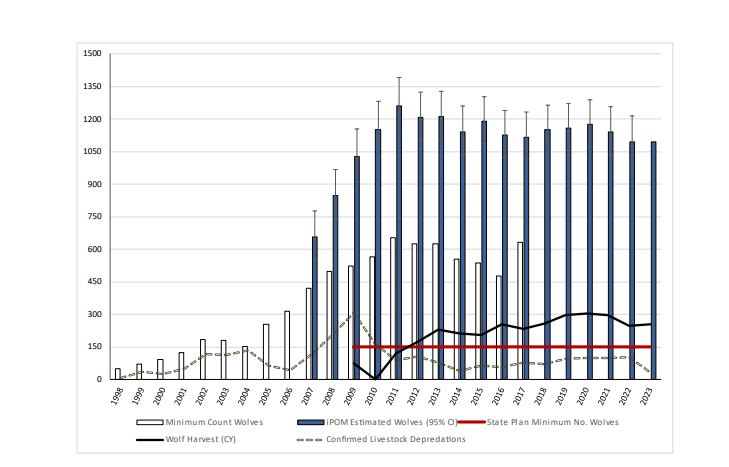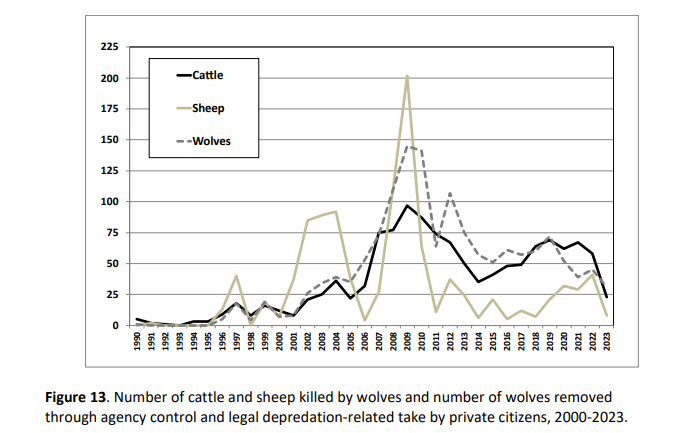Perlodid
Well-known member
What if they don't serve a purpose that you find valuable? Then what?What, exactly, is a wolf good for?
Follow along with the video below to see how to install our site as a web app on your home screen.
Note: This feature may not be available in some browsers.
What if they don't serve a purpose that you find valuable? Then what?What, exactly, is a wolf good for?
Let's get accurate. WIs I'll fated wolf season was set by politicians over the objections of professional bios in WI, who wanted. a more restrictive season.True, killed like 200 in a few days.
That includes trapping too though, and most of the wolves killed by hunters were run with dogs in ideal conditions. I’m not sure if that is a legal method of hunting wolves in Western states?
Still a ton of wolves in a very short period of time. In my opinion, the WDNR had egg on their face in the aftermath as it exposed their population estimates as being way low.
Let's get accurate. WIs I'll fated wolf season was set by politicians over the objections of professional bios in WI, who wanted. a more restrictive season.
It’s a combination in certain places like Oregon where predator and game management was already problematic, then wolves started pouring in. Now decades later it’s a real mess. Some units have half or less the bull and elk tags they used to, and several units restricted to spike bulls (not OTC, but draw and some years you can’t even draw a spike tag).I laugh when I hear hunters says they heard wolves and that all the elk are gone.
Wolves are hunting elk. If you hear wolves, it’s because elk are in the area.
Wolves don’t live in desolate places without food.

 bakercityherald.com
bakercityherald.com
Idaho has had wolves for 30 years.It’s a combination in certain places like Oregon where predator and game management was already problematic, then wolves started pouring in. Now decades later it’s a real mess. Some units have half or less the bull and elk tags they used to, and several units restricted to spike bulls (not OTC, but draw and some years you can’t even draw a spike tag).
This was published in 2021 based on a study in the NE Oregon Blue mountains (where Ive hunted since the early 90s) regarding in part wolf kill rates.
https://cdnsciencepub.com/doi/10.1139/cjz-2021-0027#abstract
"However, large carnivores tend to prefer medium-sized to large prey within multi-prey systems (e.g., Owen-Smith and Mills 2008). We expected wolves to use the most vulnerable prey classes available (reproductive vulnerability; Lima and Dill 1990), which would manifest as seasonal variation in the proportion of ungulates species and age class in wolf diet composition (Kunkel et al. 1999; Kunkel and Pletscher 2000; Smith et al. 2004; Metz et al. 2012). Substantial evidence exists demonstrating the preference of wolves for elk in multi-prey systems with elk present (Carbyn 1983; Huggard 1993a; Kortello et al. 2007; Metz et al. 2020), and we expected the most vulnerable classes of elk to dominate Oregon wolf diets, regardless of season."
"Of the 159 prey remains located, 139 were determined to be wolf predation events, 96.4% of which were native ungulates (Table 1). The remaining 3.6% were other small mammals (ground squirrel, northern flying squirrel (Glaucomys sabrinus(Shaw, 1801)), snowshoe hare, and domestic sheep). Of the 134 native ungulates identified, elk (n = 87) were the primary prey in both winter and summer monitoring periods (62.1% and 74.2%, respectively), followed by deer (n = 47, mule deer and white-tailed deer combined; 37.9% and 25.8% in winter and summer, respectively). We determined age for 74 elk and 28 deer remains at predation sites, and elk calves were the most prevalent age class of known age prey in both seasons (36.3% and 63.3% for winter and summer, respectively). However, adult elk (32.5%) were observed nearly as often as elk calves in winter wolf diets (Fig. 2). Females made up the majority of winter (76.9%) and summer (100%) adult elk located at sites where we determined sex for remains (n = 26 and n = 3, respectively). In contrast, deer were less prevalent in wolf diets than elk, but the amount of deer in diets varied by pack and season, comprising as much as 40%–50% of the diet in some cases (Table 1)."
"Cumulatively across summer and winter, wolf packs killed a mean of 2.2 ungulates/week per pack (90% CI = 1.6–2.9), and cumulative mean per wolf kill rate was 0.4 ungulates/week per wolf (90% CI = 0.2–0.5)."
"Strong selective predation on juvenile elk by cougars coupled with high density cougar populations indicated additive predation that explained low calf survival and recruitment, and reduced population growth rates of elk in this region prior to our study (Johnson et al. 2013; Clark 2014; Clark et al. 2014; Davidson et al. 2014). In this study, wolves used juvenile age classes of elk during summer and winter. If coupled with previously measured cougar densities, then this continuous use of juvenile elk by a second predator could intensify the top-down effects of carnivores on elk populations in this system."
"In many multi-prey systems, deer are often more abundant than elk, but elk are consistently selected by wolves in these systems regardless of alternate ungulate abundance (Kortello et al. 2007; Metz et al. 2020), consistent with elk use in this study. This suggests wolf predation in multi-prey systems as most likely to have population-level effects on elk rather than deer populations. Furthermore, our results are consistent with other studies of wolf predation since wolves in northeast Oregon preyed on vulnerable ungulate classes as they became seasonally available (Husseman et al. 2003; Smith et al. 2004; Atwood et al. 2007; Kortello et al. 2007; Metz et al. 2012). As predicted, elk calves made up the majority of prey in wolf summer diets in our study due to the influx of vulnerable neonates available on the landscape associated with ungulate birth pulses. Juveniles are more vulnerable in their first months of life not only because of their size (smaller), but also their inexperience (i.e., knowledge toward evading predators). Furthermore, juvenile vulnerability extends into winter because they have placed much of their energy reserves into growth and may have reduced fat reserves compared with adults entering winter. Smaller body size for juveniles entering winter may also make them less able to escape wolves in adverse environmental conditions, such as deep snow (Nelson and Mech 1986; Huggard 1993b; Jȩdrzejewski et al. 2002). However, deer fawns were likely underrepresented in our study because GPS location cluster methods can be biased against locating predation sites for very small prey (e.g., neonate deer <4 kg) due to short handling times (Demma et al. 2007; Planella et al. 2016), so their contribution to summer wolf diets requires further investigation.
Winter kill rates for wolf packs documented in our study (1.3–2.1 ungulates/week) were on the low end of ratio estimates reported in similar wolf–elk systems (Banff National Park — 1.5–2.4 kills/week: Hebblewhite et al. 2003; 2.0–3.6 elk/week: Kortello et al. 2007)."

Oregon estimated wolf population up 15% in 2024 - Baker City Herald
SALEM — Oregon’s estimated wolf population grew by about 15% in 2024, rising from 178 to 204 animals, according to the annual wolf conservation and management report released April 11 by the Oregon Department of Fish and Wildlife.bakercityherald.com
Thats great. And you have a wolf hunting season with $50 tags or however much they cost now. We can’t hunt them. Back in the early 2000s i knew a guy living out of Couer d’lene who saw his elk hunt impacted by wolves. Things eventually got better.Idaho has had wolves for 30 years.
Elk figure out how to live with wolves. The unit I live in has surplus elk population, a large wolf presence (I can hear two different wolf packs from my house on occasion - seen wolves from my house), and one of the largest hunter elk kills. It wasn’t this way 20 years ago.
So, the apocalypse is not imminent?Idaho has had wolves for 30 years.
Elk figure out how to live with wolves. The unit I live in has surplus elk population, a large wolf presence (I can hear two different wolf packs from my house on occasion - seen wolves from my house), and one of the largest hunter elk kills. It wasn’t this way 20 years ago.
$13.50 for resident wolf tag and $31.50 for non-residents.Thats great. And you have a wolf hunting season with $50 tags or however much they cost now. We can’t hunt them. Back in the early 2000s i knew a guy living out of Couer d’lene who saw his elk hunt impacted by wolves. Things eventually got better.
Just don’t complain if I shoot more of your Idaho bulls because I can’t draw an Oregon spike tag.
Moose are coming back too. I’m seeing moose in areas I’ve glassed almost 20 years without seeing a moose until the recent years.So, the apocalypse is not imminent?
Lucky; ours seem to be at best treading water. My opinion though is ticks and highways are killing more than hunters and wolvesMoose are coming back too. I’m seeing moose in areas I’ve glassed almost 20 years without seeing a moose until the recent years.


$13.50 for resident wolf tag and $31.50 for non-residents.
You can come wolf hunt here. You probably won’t see one. Trapping is a way better way to kill wolves.